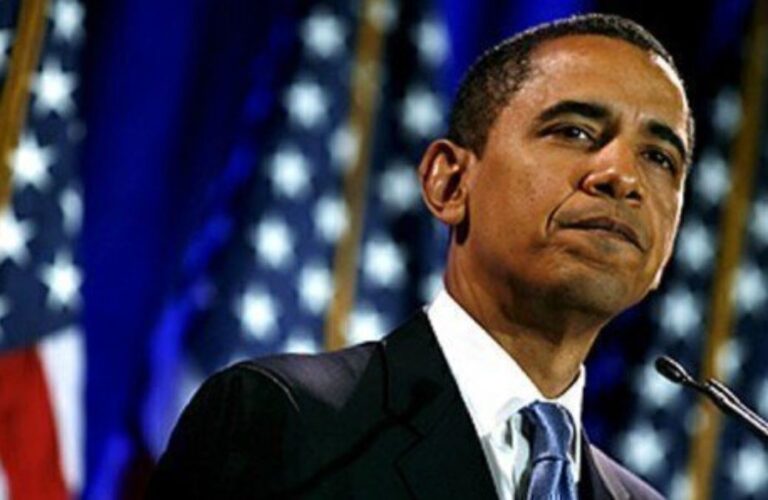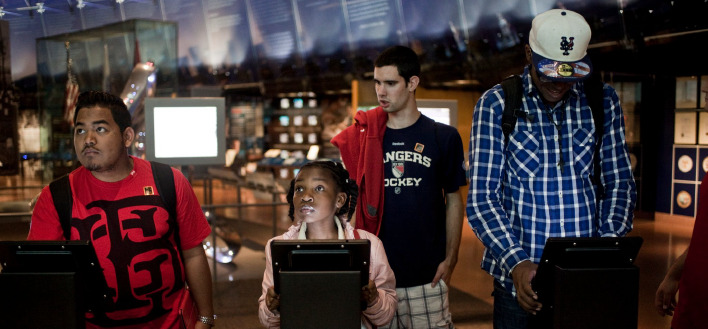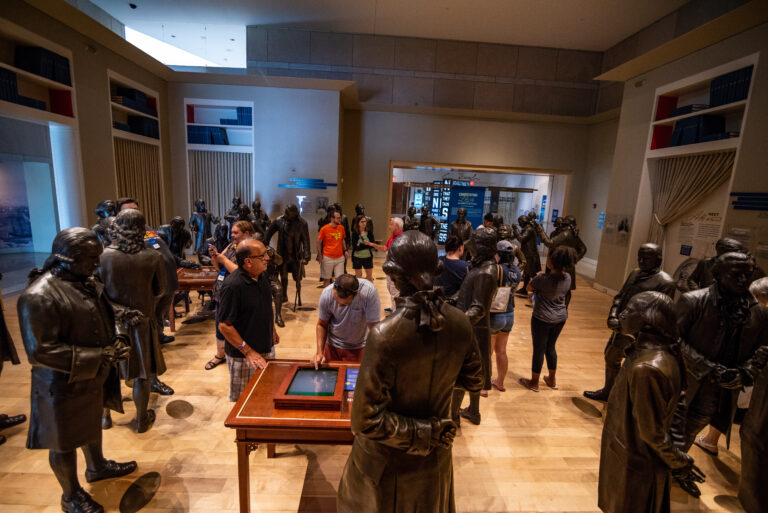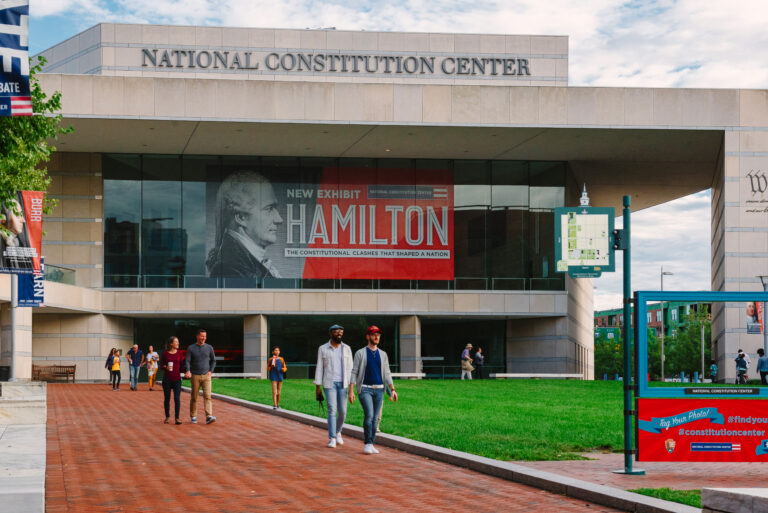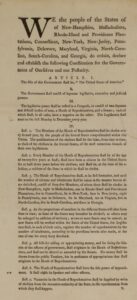National Constitution Center
Essay
Created in 1988 by the Constitution Heritage Act, the National Constitution Center in Philadelphia played a role in debates about the future of the Independence Mall area of Independence National Historical Park as a tourist draw and as a historic site that represented American national identity even before it was built. From its opening in 2003, the NCC used exhibits, programs, and performance to engage with the Constitution not only as a historical document, but also as a legal framework, a set of ideas, and a site of struggle both past and present. In the late 2010s, its identity as a site of education and political debate found new relevance in presenting a diverse and inclusive history of the United States as well as serving a polarized nation as a reliable, fact-based resource.
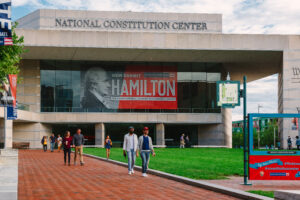
The sponsors of the Constitution Heritage Act imagined an institution that would carry on the aims of the 1987 bicentennial of the Constitution and continue its educational project. Beyond the truism of Constitutional history as a vital part of American law, politics, democracy, and citizenship, advocates argued the NCC should inspire citizens in the present to participate in democracy and celebrate American ideals. Its educational mission aimed “to increase the awareness and understanding of the Constitution.” A 1998 opinion poll conducted by the museum found that more teenagers could name the Three Stooges than the three branches of government.
Philadelphia Mayor Edward Rendell (b. 1944), a key supporter of the NCC, incorporated it into his push for the redevelopment of Independence Mall. Rendell’s aim was to bolster the tourism economy in Philadelphia by revitalizing its familiar historic resources and building new ones. Ultimately, Rendell, U.S. Senator Arlen Specter (1930-2012), NCC founding President Joseph Torsella (b. 1963), and others mobilized $86 million from state and federal governments as well as $5 million from the city and $10.5 million from the Delaware River Port Authority to support the construction and development of the museum. However, despite its federal mandate and its public funding, the NCC itself was a private institution and individual gifts were equally important to creating and sustaining it. Key early contributions came from Walter (1908-2002) and Leonore Annenberg (1918-2009) and Richard (1926-2018) and Helen DeVos (1927-2017), each couple donating $10 million.
The museum opened on July 4, 2003, at Fifth and Arch Streets with a view of Independence Hall three blocks to the south. The NCC’s invitation was to “Enter a visitor. Leave a citizen,” suggesting that participation and engagement with the ideas of freedom and democracy were more central to the museum experience than learning the names and dates associated with a 200-year-old document.
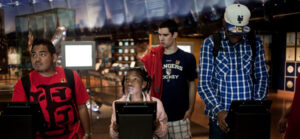
“We the People” Exhibit
The museum housed the main exhibit—“The Story of We the People”—in a massive, round exhibit hall. In the center was a sharply stepped 360-degree theater staging hourly live, multimedia performances of “Freedom Rising.” Around the perimeter was a circular exhibit, a timeline of American history from the Stamp Act of 1765 to the Patriot Act of 2001. It brought legal history together with the history of politics and democracy to explore key themes of national identity. A dizzying array of text, primary sources, secondary sources, objects, sculpture, sound, video, and interactives—both digital and analog—narrated these histories offering traditional textual approaches to museum display and participatory modes of engagement. While the format stayed the same, the museum updated displays periodically to include post-2003 events like the election of Barack Obama (b. 1961). It also revised its discussion of the Civil War and Reconstruction to reflect the historiography of a later exhibit that explored both the successes and failures of the Thirteenth, Fourteenth, and Fifteenth Amendments.
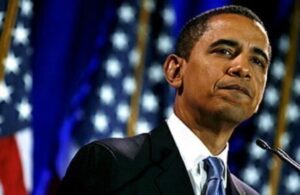
To uphold its nonpartisan mission, the museum has sought to straddle party lines and ideological divides. Supreme Court Justices Antonin Scalia (1936-2016) and Stephen Breyer (b. 1938) were on the advisory board for the opening and, despite their opposing political ideologies, were both pleased with the resulting exhibits. On the contemporary Supreme Court, the Constitutional interpretation was the subject of an ongoing ideological battle between originalists like Scalia and pragmatists like Breyer. At the Constitution Center, however, exhibits highlighted familiar debates like those over voting rights or race and gender equality as narratives of progress and an evolving national consensus. Educational programs and speakers sometimes focused more on debate and sometimes were more contentious. Together, the whole of the institution, from funders to supporters to school groups, offered multiple approaches that ultimately created balanced discussion as the ideal way to understand politics and the Constitution.
The timeline format of the main exhibit showed how the Constitution changed over time—usually in favor of equality and inclusivity. Highlighting these changes further were panels mounted above the visitor upon which the text of the Constitution was etched in glass with notes marking changes that later amendments made to the original document. The Interactive Constitution, an online digital resource, used a similar method of annotation as well as essays and commentary to explore Constitutional history and debate in-depth. The development of the Interactive Constitution began in 2015 with funding from the John Templeton Foundation. It was a collaboration with the Federalist Society, a conservative and libertarian think tank, and the American Constitution Society, a progressive counterpart.
Since its opening, the National Constitution Center also has featured an array of temporary exhibits, some more closely related to the Constitution than others. The NCC’s concerns about generating public interest, and thus admissions, factored into programming decisions and worried some critics that the efforts to be popular were causing it to drift from its mission. A 2009 exhibit on Diana, Princess of Wales (1961-99) was a particularly glaring attempt to attract visitors without regard to the institutional and educational mission. The first decade of the 2000s was a moment when many museums were turning to flashy exhibits produced by for-profit entertainment companies to enhance revenues. However, the Constitution Center’s own internal financial struggles should also be understood in context of the unique competition it faced from free historical and educational sites like Independence Hall and the Liberty Bell nearby.
Interactive Theater Program
In the 2010s, the NCC adopted new strategies while retaining old ones. The museum began producing exhibits in-house that engaged more directly with Constitutional issues and showed their relevance to everyday life in the present. Some of those exhibits also toured. In 2010, the museum revitalized its educational mission with the interactive theater program “The Living News.” In 2015, it also took on a local collaboration in curating “Speaking Out for Equality: The Constitution, Gay Rights, and the Supreme Court” with the William Way LGBT Community Center in Philadelphia.
In 2013, the National Constitution Center hired Jeffrey Rosen (b. 1964) as its sixth—and by 2021 its longest serving—President and CEO. He was the first legal scholar to lead the institution. While there was a continued focus on education and K-12 school groups, Rosen also led multipartisan academic engagement with the Constitution through programs like the Interactive Constitution and “America’s Town Hall” which brought together conservative and liberal scholars to discuss historic and contemporary issues in law and politics. In the name of balanced debate, these programs showed the Constitution as a site of struggle whose meaning was unsettled.
In 2019 and 2021, the museum opened large exhibits curated in-house on the Civil War and on the 19th Amendment. These extended the traditional display strategies—artifacts and textual labels informed by historical scholarship—used elsewhere. The former also contained digital interactives that, like other Constitution Center projects, used the process of revision—in this case revision of the Reconstruction amendments prior to their passage—to show the complex political as well as linguistic trajectories that led to the evolution of the law and society. In addition, the museum launched FOURTEEN, another educational theater program, about lesser known histories of the Black experience after the Civil War. The Pew Foundation funded the program with Black writers and performers from Philadelphian leading its creation.
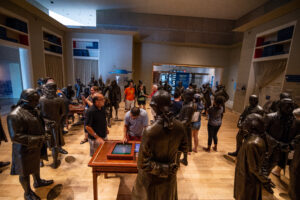
Consideration of race and gender in the history of a document authored by white men, many of whom enslaved people, reflected the progressive ethos of a moment when many Americans were reconsidering the stories they had long told about their national past. However, this period saw the NCC capture other political currents as well. It made itself a place to turn to for civil discourse and trustworthy, balanced information about the law, the Constitution, and American history amidst attacks on all three. Said Rosen in 2020: “People are hungry for an alternative to the partisan paralysis and clashes that are paralyzing Washington, and that is what the framers intended: A constitution shaped by the understanding of the people.” The NCC embodied what people often imagine museums—and the Constitution—to be: neutral, trusted authorities. At the same time, the NCC’s programs and its new exhibits showed that the Constitution was actually defined by partisan clashes. It was not neutral and in fact had always been a site of constant struggle for freedom, equality, and democracy.
Mabel Rosenheck is a public historian, independent scholar, and lecturer based in Philadelphia. (Author information current at time of publication.)
Copyright 2022, Rutgers University.
Gallery
Backgrounders
Connecting Headlines with History
- The National Constitution Center celebrates its first decade (WHYY, July 2, 2013)
- Obama’s ‘more perfect union,’ eight years later by Dave Heller (WHYY, March 18, 2016)
- At the Constitution Center, who made the 19th Amendment, and who was left out by Peter Crimmins (WHYY, August 25, 2020)
- Performing the Reconstruction Era (in its own words) in ‘FOURTEEN’ at National Constitution Center by Peter Crimmins (July 11, 2019)
